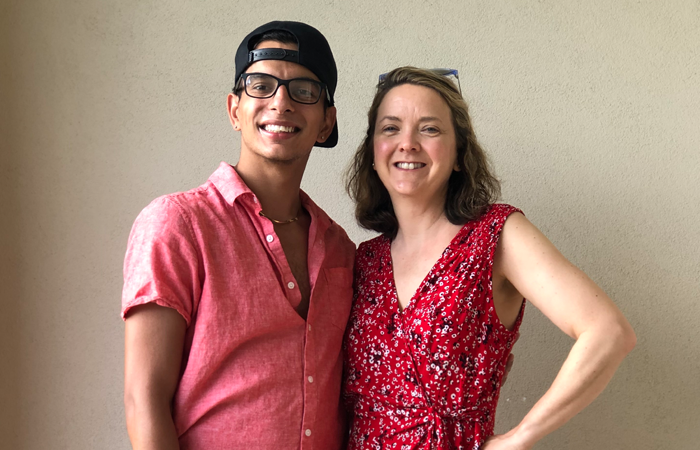By the time your child reaches his preteen years, you will have probably laid the foundation and tried to create a safe family environment for talking about adoption. When your child was very young, he likely enjoyed hearing his adoption story and happily parroted it to anyone who would listen–even before he understood it all. Around ages six to eight, children begin to differentiate fantasy and reality, and to realize that adoption means they have two sets of parents.
And sometime between ages nine and 12, you notice that your tween rolls her eyes when adoption is mentioned, refuses to engage in discussion, stops coming to you with questions, and expresses feelings that surprise you. Children who once accepted the facts of their adoption may exhibit sad or ambivalent feelings. They may withdraw from adoption-related events, or clam up when the talk turns to adoption.
Kids at this stage are developing coping skills and are learning to rely on themselves more. This is the beginning of their independence, and they use this opportunity to experiment with problem-solving, test the limits of their independence, and take responsibility for their feelings.
Communicating with your growing child becomes more complicated. You know that feelings about adoption are beneath the surface, but how do you keep the conversation going, or at least send the signal that you’re open to talking? Parents may need to change their role from commander-in-chief to that of a guide. Be understanding, approach conversation with a caring attitude, and recognize that, while you know this is a passing phase, it is a here-and-now reality for your child.
Here are the four developmental tasks for this stage, and ways to keep talking to tweens:
Exploring Feelings About Birth Parents
Cognitive development at the tween stage is uneven, because tweens still see situations as either all good or all bad. A tween will imagine that something was either wrong with him or with his birth mother that led to placement. Tweens wonder, “Why didn’t my birth parents keep me?” even if they seemed to understand your earlier explanations. James R., 10, from Yardley, Pennsylvania, was told he was placed because his birth mother could not raise him as a single parent. When he began to notice that many single parents keep their babies, new questions arose.
On her tenth birthday, Madison*, from Cherry Hill, New Jersey, shared her profound awareness that “I could have had a whole different life.” Madison realized that adoption meant that she might have been raised by different parents, and she became more curious than ever before. She tried to imagine what her life would have been like if she had been raised by her birth parents. Although it was an open adoption, Madison had not seen her birth mother in four years. The family arranged a visit, and Madison developed a more concrete picture of her birth mother’s life. Afterward, Madison and her mother discussed her new awareness of the difficulties her birth family had.
Parents can help their child temper his black-and-white thinking with a more empathetic view of both themselves and their birth parents. Let your child lead the conversation–you may be surprised to learn that your child associates his adoption with his misbehavior. Be honest, and keep the conversation positive and nonjudgmental, because your child will identify with his birth parents at some point. This is a good time to explain that there is usually more than one reason for a person to make a decision. James’s parents explained that his birth mother was unable to parent him because she was single, without family support, in debt, and in need of time to learn skills to get a job.
Given their new awareness about feelings, tweens may be concerned that talking about adoption is disloyal and will hurt their parents’ feelings. Let your child know you are open to talking and are interested in what he is feeling. He will be relieved when you open the door. Look for ways to bring up birth parents in conversation. You might say, “You are such an amazing singer. I wonder if you inherited that talent from one of your birth parents?” Make available books, articles, movies, or television shows that deal with adoption, as these might spark conversation. Or make the topic more approachable with humor–share a funny story from the early days of the adoption.
Questioning Permanence
As children connect emotionally with the reality that their birth parents placed them, some experience separation anxiety. Although the politically correct term is “placed for adoption,” many children hear “given up.” The underlying fear is, “If my birth parents could give me away, would my adoptive parents ever do the same?”
Children typically exhibit this anxiety in one of two ways: by testing their parents’ attachment or, at the other end of the spectrum, by acting with extreme compliance. Alexis, 11, from Arlington, Virginia, would test her parents by saying, “My real parents would let me stay up until midnight.” Children need to know that you can tolerate their anger, and want to see how much you believe in the stability of the family.
Watch for behaviors that are not compatible with the family rules and norms. Tweens who imagine their birth parents were “bad” may try to test whether they are also bad–and, if so, are they still lovable? Discuss your tween’s perceptions about her birth parents, as she begins to sort out “what is really me, and what did I inherit?”
The opposite side of the insecurity coin is extreme compliance. Some adoptees are so fearful of rejection that they are afraid to be themselves. Isabelle, 11, from Doylestown, Pennsylvania, found every opportunity to be good, in the hope that she could guarantee love and security. She offered to help her friend’s mother carry groceries rather than join the other kids on the playground. Parents with compulsively compliant kids can reassure them directly: “I will love you, even if you go play!”
This is a good time to talk about love and commitment, and how forever relationships work. Counter tweens’ black-and-white thinking with examples of how you accept both the good and the bad in people you love.
Coping with Emotions of Adoption
Tweens have quick access to their emotions, and some may grieve as they come to understand fully that their birth parents are real people who made the decision to place them. Even those adopted as babies may feel sad about their first families.
Allie*, 11, from Brooklyn, New York, says, “Adoption is bittersweet–sometimes I’m happy because I get to have a better life, and sometimes I’m sad because it is hard to leave my mom. I miss her.” Although Allie was adopted as a newborn, her parents validate her feelings, “even when it is hurtful to us or when we are tempted to minimize or deny her feelings,” says her mother. “We don’t tell her that she can’t possibly miss her birth mother, because she only saw her for one day, and we don’t say she shouldn’t miss her because she has us. We want her to feel free to talk to us, without worrying about our feelings.” This lets Allie know that her parents understand how she feels.
Not all children are as direct as Allie. Some show their emotions by exhibiting intense grief at other kinds of losses, exclusions, and rejections, or by withdrawing from social activities. Birthdays or Mother’s Day may be difficult.
These emotions are perfectly normal for some children in processing what it means to have been adopted. Children report that being able to share these feelings with their parents makes a world of difference to them. They appreciate knowing that their parents do not take their feelings as personal rejection. Parents can help a lot just by naming the feeling–labeling the adoption-related sadness for your child–and letting her know that she is having normal feelings.
Coming to Terms with Adoption and Race
Tweens want to fit in with their peers, so they may not want to tell them that they were adopted or that they are of a particular heritage or race. Stephanie Case, from Stillwater, Oklahoma, says, “Our 10-year-old daughter would rather people not know she was adopted. This can be hard, as she is multiracial, and her father and I are not. We have a very open adoption, but she has become reluctant to continue having her birth parents visit. I have tried to reassure her that it is OK to have these feelings, and I let her decide whether to include her birth family in events.”
Tweens look beyond their parents for role models, frequently to peers or to movie or TV characters. You can support and guide them by introducing them to good role models, such as teens or adults who were adopted or those who share their race or heritage. If your child withdraws from people of her own culture or race, try to find out why. She may have heard a negative stereotype or prejudice, and, if so, you will want to find ways to negate it.
Adoption peer groups are popular among kids this age. Peer groups offer an outside-the-family chance to discuss adoption, race, birth parents, and adoptive parents, and to learn how to handle the questions and comments they get from their non-adopted peers. Sarah, age 11, who was adopted from Nepal, shared her feelings with her group. “I hate it when people ask me if I am Hawaiian or if I speak Spanish,” she said. It helped to hear a validating response from Jackie, age 11: “I know. People always ask me if I speak Chinese.”
While some tweens start paying attention to their physical appearance in a positive way, others become insecure. Read magazines together to open a dialogue about appearance, and learn why your child is feeling insecure. She may be wondering what she will look like as an adult, or she may be disconcerted by not knowing anyone who looks like her. Spending time with adult or teen role models, or peers of the same race–shopping together or simply hanging out–can make your tween more comfortable with her appearance.
Communicating with tweens is not easy. You have to shift from being the problem-solver to being a supportive guide for your child, as he experiences and processes deeper feelings. And you will be letting your child take the lead more often.
As Heidi Wheeler, a mom of six, in Asheboro, North Carolina, says, “I believe, once children start to process adoption, it’s better to leave the ball in their court and let them talk about it when they need to. It’s something they have to process for the rest of their life. It is their personal journey, and we love and support them.”
This difficult phase can bring your family closer together, and it gives your child a chance to grow by leaps and bounds.
*Names have been changed to preserve privacy.


